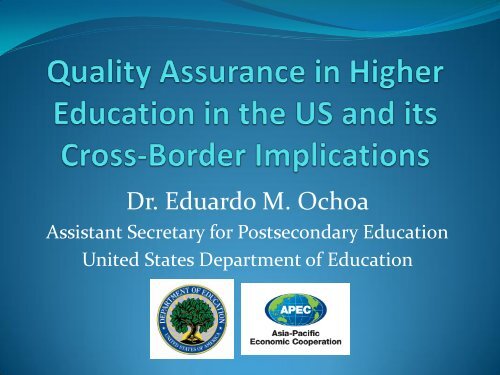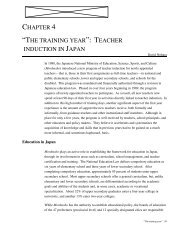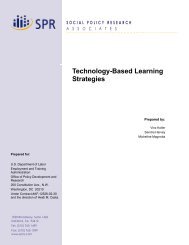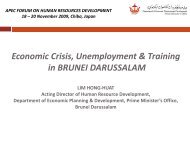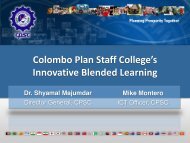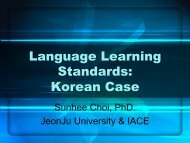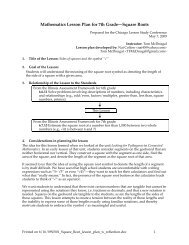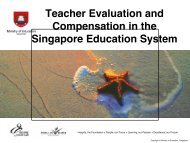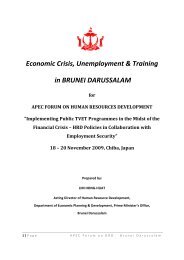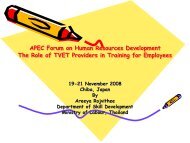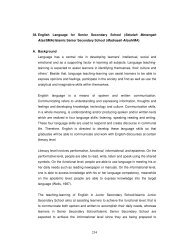Quality Assurance in Higher Education in the US and its Cross ...
Quality Assurance in Higher Education in the US and its Cross ...
Quality Assurance in Higher Education in the US and its Cross ...
Create successful ePaper yourself
Turn your PDF publications into a flip-book with our unique Google optimized e-Paper software.
Dr. Eduardo M. Ochoa<br />
Assistant Secretary for Postsecondary <strong>Education</strong><br />
United States Department of <strong>Education</strong>
Overview of Remarks<br />
• The higher education <strong>and</strong> quality assurance<br />
systems <strong>in</strong> <strong>the</strong> <strong>US</strong><br />
• Governmental recognition of accredit<strong>in</strong>g agencies<br />
• Non-Governmental recognition of accredit<strong>in</strong>g<br />
agencies<br />
• <strong>Cross</strong>-border quality assurance <strong>and</strong> two models of<br />
cooperation<br />
• Policy considerations
Decentralized Diverse System<br />
• No Federal M<strong>in</strong>istry of <strong>Education</strong> – <strong>US</strong> Constitution<br />
gives States authority over education<br />
• Over 6,700 <strong>in</strong>stitutions<br />
Private for-Profit non-degree<br />
21.0%<br />
Private not-for-Profit non-degree<br />
Public non-degree<br />
1.2%<br />
3.3%<br />
Private for-Profit degree-grant<strong>in</strong>g<br />
Private not-for-Profit degree-grant<strong>in</strong>g<br />
Public degree-grant<strong>in</strong>g<br />
22.7%<br />
25.6%<br />
26.2%
<strong>Quality</strong> <strong>Assurance</strong> via Accreditation<br />
• Orig<strong>in</strong>s <strong>in</strong> late 19 th <strong>and</strong> early 20 th centuries<br />
• Non-governmental purposes<br />
• Voluntary membership organizations<br />
• St<strong>and</strong>ards developed by members<br />
• Peer review<br />
• Mission-based evaluation<br />
• Goals:<br />
• Basic level of quality<br />
• Improvement
Types of Accredit<strong>in</strong>g Agencies<br />
• Institutional<br />
• Regional – traditional/primarily not-for-profit<br />
• National career/technical – for profit<br />
• Religious<br />
• Specialized or Programmatic<br />
• S<strong>in</strong>gle profession or discipl<strong>in</strong>e<br />
• State – NY State Board of Regents <strong>and</strong> state agencies<br />
for approval of postsecondary vocational programs <strong>and</strong><br />
nurs<strong>in</strong>g programs
Examples of Agency Types<br />
• Regional accredit<strong>in</strong>g<br />
agencies<br />
• New Engl<strong>and</strong> Association<br />
of Schools <strong>and</strong> Colleges<br />
• Sou<strong>the</strong>rn Association of<br />
Colleges <strong>and</strong> Schools<br />
• Western Association of<br />
Schools <strong>and</strong> Colleges –<br />
senior <strong>and</strong> junior<br />
• North Central Association<br />
<strong>Higher</strong> Learn<strong>in</strong>g<br />
Commission<br />
• Northwest Commission on<br />
Colleges <strong>and</strong> Universities<br />
• National accredit<strong>in</strong>g<br />
agencies<br />
• Accredit<strong>in</strong>g Commission<br />
of Career Schools <strong>and</strong><br />
Colleges<br />
• Accredit<strong>in</strong>g Council for<br />
Independent Colleges <strong>and</strong><br />
Schools<br />
• Distance <strong>Education</strong> <strong>and</strong><br />
Tra<strong>in</strong><strong>in</strong>g Council<br />
• Council on Occupational<br />
<strong>Education</strong><br />
• Accredit<strong>in</strong>g Board of<br />
Health <strong>Education</strong> Schools
Examples of Agency Types<br />
• Programmatic<br />
• National League for<br />
Nurs<strong>in</strong>g Accredit<strong>in</strong>g<br />
Commission<br />
• American Psychological<br />
Association<br />
• Liaison Committee on<br />
Medical <strong>Education</strong><br />
• National Council for<br />
Accreditation of Teacher<br />
<strong>Education</strong><br />
• Religious<br />
• Association for Biblical<br />
<strong>Higher</strong> <strong>Education</strong><br />
• Association of<br />
Advanced Rabb<strong>in</strong>ical<br />
<strong>and</strong> Talmudic Schools<br />
• Association of<br />
Theological Schools<br />
• Transnational<br />
Association of Christian<br />
Colleges <strong>and</strong> Schools
Frequency of Reviews<br />
• Time between comprehensive reviews varies from<br />
3 to 10 years<br />
• Full self study<br />
• Site team visit of 2-5 days<br />
• Follow up reviews/reports/vis<strong>its</strong><br />
• Mid-cycle reviews<br />
• Annual report<strong>in</strong>g<br />
• Substantive change applications
Types of St<strong>and</strong>ards<br />
• Vocational accreditors generally prescriptive<br />
• Require report<strong>in</strong>g of retention, graduation <strong>and</strong> job<br />
placement rates<br />
• If applicable, establish benchmarks for licensure<br />
passage rates<br />
• May specify curriculum<br />
• Regional accredit<strong>in</strong>g agencies more general<br />
• Missions of <strong>in</strong>stitutions that are regionally<br />
accredited differ significantly<br />
• Measures of student achievement more complex –<br />
qualitative as well as quantitative
Federal Oversight<br />
• Secretary of <strong>Education</strong> recognizes accredit<strong>in</strong>g<br />
agencies as “reliable authorities regard<strong>in</strong>g <strong>the</strong><br />
quality of <strong>the</strong> education or tra<strong>in</strong><strong>in</strong>g provided by<br />
<strong>the</strong> <strong>in</strong>stitutions <strong>and</strong> programs <strong>the</strong>y accredit.”<br />
• Only agencies that have a “federal l<strong>in</strong>k” can apply<br />
for recognition<br />
• Congress has specified criteria by which agencies<br />
will be evaluated; fur<strong>the</strong>r elaborated through<br />
regulations<br />
• Reviewed at least every five years
Recognition Review Process<br />
• Accreditation staff review <strong>and</strong> analyze agency<br />
petitions; make a recommendation to Assistant<br />
Secretary on <strong>the</strong> recognition of each agency<br />
• Agency petitions <strong>and</strong> staff analyses are provided to an<br />
external advisory committee comprised of <strong>in</strong>dividuals<br />
appo<strong>in</strong>ted by <strong>the</strong> House, Senate, <strong>and</strong> Secretary of<br />
<strong>Education</strong><br />
• Public hear<strong>in</strong>g of <strong>the</strong> committee attended by staff <strong>and</strong><br />
agency representatives<br />
• Committee makes <strong>its</strong> recommendation to <strong>the</strong><br />
Assistant Secretary on <strong>the</strong> recognition of each agency
Scope of Recognition<br />
• Each agency is recognized for a range of accredit<strong>in</strong>g<br />
activities<br />
• Secretarial recognition is limited to an agency’s<br />
accreditation of U.S. <strong>in</strong>stitutions<br />
• Some agencies do accredit non-U.S. <strong>in</strong>stitutions<br />
• Regional agencies have adopted Pr<strong>in</strong>ciples of Good<br />
Practice <strong>in</strong> Overseas International <strong>Education</strong><br />
Programs for Non-U.S. Nationals<br />
http://cihe.neasc.org/downloads/POLICIES/Pp47_Overseas_<br />
programs_for_non-<strong>US</strong>_Nationals.pdf
Student Achievement<br />
• Agencies are required to have st<strong>and</strong>ards that address<br />
an <strong>in</strong>stitution’s or program’s success with respect to<br />
student achievement <strong>in</strong> relation to mission<br />
• Accredit<strong>in</strong>g agencies provide resources <strong>and</strong> tra<strong>in</strong><strong>in</strong>g on<br />
effectively assess<strong>in</strong>g student achievement – slowly<br />
grow<strong>in</strong>g expertise <strong>in</strong> higher education community<br />
• Controversy around mak<strong>in</strong>g comparisons across<br />
<strong>in</strong>stitutions <strong>and</strong> us<strong>in</strong>g st<strong>and</strong>ardized assessments<br />
• Voluntary System of Accountability – supported by a<br />
grant from <strong>the</strong> Department of <strong>Education</strong><br />
http://www.collegeportra<strong>its</strong>.org/
Non-Governmental Recognition<br />
• Council on <strong>Higher</strong> <strong>Education</strong> Accreditation (CHEA)<br />
also recognizes accredit<strong>in</strong>g agencies<br />
• A basic eligibility requirement is that a majority of <strong>the</strong><br />
<strong>in</strong>stitutions <strong>and</strong> programs accredited by <strong>the</strong> agency<br />
grant higher education degrees<br />
• Because of different eligibility requirements, agencies<br />
may be recognized by <strong>the</strong> Secretary, by CHEA, or by<br />
both entities<br />
• CHEA’s scope of recognition may <strong>in</strong>clude non-<strong>US</strong><br />
<strong>in</strong>stitutions<br />
http://www.chea.org/pdf/CHEA_<strong>US</strong>DE_AllAccred.pdf
<strong>Cross</strong>-Border <strong>Quality</strong> <strong>Assurance</strong><br />
• CHEA has developed resources <strong>and</strong> <strong>in</strong>formation on<br />
<strong>in</strong>ternational quality assurance <strong>in</strong>clud<strong>in</strong>g --<br />
• A directory of quality assurance agencies <strong>and</strong><br />
accreditation bodies <strong>in</strong> 175 countries<br />
• Glossary of key terms <strong>in</strong> quality assurance<br />
• Statements on quality assurance across borders<br />
• Pr<strong>in</strong>ciples for <strong>US</strong> Accreditors Work<strong>in</strong>g Internationally:<br />
Accreditation of non-<strong>US</strong> Institutions <strong>and</strong> Programs<br />
http://www.chea.org/default.asp?l<strong>in</strong>k=6
International Eng<strong>in</strong>eer<strong>in</strong>g Alliance<br />
• Six <strong>in</strong>ternational agreements govern<strong>in</strong>g mutual<br />
recognition of eng<strong>in</strong>eer<strong>in</strong>g qualifications <strong>and</strong><br />
professional competence<br />
• Three agreements cover mutual recognition <strong>in</strong> respect of<br />
tertiary-level qualifications <strong>in</strong> eng<strong>in</strong>eer<strong>in</strong>g<br />
• Three agreements cover recognition of equivalence at<br />
<strong>the</strong> practic<strong>in</strong>g eng<strong>in</strong>eer level i.e. it is <strong>in</strong>dividual people,<br />
not qualifications that are seen to meet <strong>the</strong> benchmark<br />
st<strong>and</strong>ard. One is <strong>the</strong> APEC Eng<strong>in</strong>eer.<br />
• 19 countries are <strong>in</strong>volved to some extent, <strong>in</strong>clud<strong>in</strong>g 7<br />
APEC countries
Comparability of Medical Degree<br />
• Committee appo<strong>in</strong>ted by Secretary of <strong>Education</strong><br />
charged with determ<strong>in</strong><strong>in</strong>g whe<strong>the</strong>r st<strong>and</strong>ards of<br />
accreditation used by ano<strong>the</strong>r economy to accredit<br />
medical schools is comparable to <strong>the</strong> st<strong>and</strong>ards of<br />
accreditation applied to M.D. programs <strong>in</strong> <strong>the</strong> U.S.<br />
• Accreditation staff do <strong>in</strong>itial review/analysis of each<br />
application.<br />
• U.S. students attend<strong>in</strong>g medical schools <strong>in</strong> comparable<br />
countries may get federal student loans.<br />
• 24 countries have been determ<strong>in</strong>ed to be comparable<br />
(five are APEC countries); six more plan to apply
Policy Questions<br />
• <strong>US</strong> Accreditation—Benchmark or Model?<br />
• Harmoniz<strong>in</strong>g Credentials—Applicability of EU Model<br />
• Student Mobility <strong>and</strong> <strong>Quality</strong> <strong>Assurance</strong>


